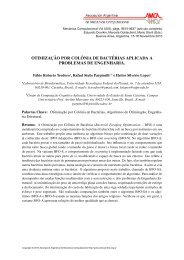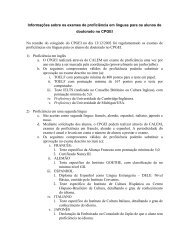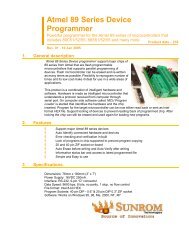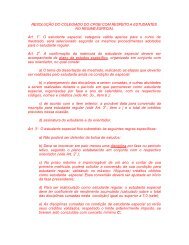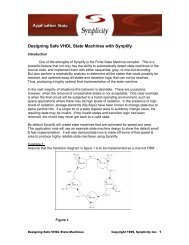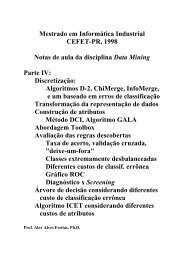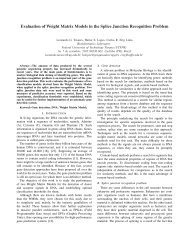- Page 1 and 2:
Lecture Notes in Computational Scie
- Page 3 and 4:
Editors Karl Heinz Hoffmann Institu
- Page 5 and 6:
Preface High performance computing
- Page 7 and 8:
Contents Part I Implementions Paral
- Page 9 and 10:
Parallel Programming Models for Irr
- Page 11 and 12:
Parallel Programming Models for Irr
- Page 13 and 14:
surface element j Parallel Programm
- Page 15 and 16:
quadtree of polygon A Parallel Prog
- Page 17 and 18:
Parallel Programming Models for Irr
- Page 19 and 20:
Parallel Programming Models for Irr
- Page 21 and 22:
Parallel Programming Models for Irr
- Page 23 and 24:
Parallel Programming Models for Irr
- Page 25 and 26:
Parallel Programming Models for Irr
- Page 27 and 28:
References Parallel Programming Mod
- Page 29:
Parallel Programming Models for Irr
- Page 32 and 33:
26 Arnd Meyer 2 Finite element comp
- Page 34 and 35:
28 Arnd Meyer and (7). Here we watc
- Page 36 and 37:
30 Arnd Meyer (1) v s := Ksq s (2)
- Page 38 and 39:
32 Arnd Meyer w = Q˜y This is agai
- Page 40 and 41:
34 Arnd Meyer and constant number o
- Page 43 and 44:
A Performance Analysis of ABINIT on
- Page 45 and 46:
A Performance Analysis of ABINIT on
- Page 47 and 48:
A Performance Analysis of ABINIT on
- Page 49 and 50:
Call graph A Performance Analysis o
- Page 51 and 52:
A Performance Analysis of ABINIT on
- Page 53 and 54:
A Performance Analysis of ABINIT on
- Page 55 and 56:
A Performance Analysis of ABINIT on
- Page 57:
A Performance Analysis of ABINIT on
- Page 60 and 61:
54 Matthias Pester and obvious fiel
- Page 62 and 63:
56 Matthias Pester • The program
- Page 64 and 65:
58 Matthias Pester SFB 393 - TU Che
- Page 66 and 67:
60 Matthias Pester SFB 393 - TU Che
- Page 68 and 69:
62 Matthias Pester or time-dependen
- Page 70 and 71:
64 Matthias Pester 5. G. Haase, T.
- Page 72 and 73:
68 Arnd Meyer TL = {T ⊂ Ω},T ar
- Page 74 and 75:
70 Arnd Meyer 3 Basic facts on hier
- Page 76 and 77:
72 Arnd Meyer Φl = ΦLQl ∀l =0,.
- Page 78 and 79:
74 Arnd Meyer Example 5: VL = V (3,
- Page 80 and 81:
76 Arnd Meyer (c) piecewise quadrat
- Page 82 and 83:
78 Arnd Meyer 6 Crack growth Table
- Page 84 and 85:
80 Arnd Meyer can access from its e
- Page 86 and 87:
82 Arnd Meyer where and This leads
- Page 88 and 89:
84 Arnd Meyer 10 A numerical exampl
- Page 91 and 92:
Nitsche Finite Element Method for E
- Page 93 and 94:
Nitsche Finite Element Method for E
- Page 95 and 96:
Nitsche Finite Element Method for E
- Page 97 and 98:
Nitsche Finite Element Method for E
- Page 99 and 100:
Nitsche Finite Element Method for E
- Page 101 and 102:
Nitsche Finite Element Method for E
- Page 103 and 104:
Nitsche Finite Element Method for E
- Page 105 and 106:
approximate solution u h pointwise
- Page 107 and 108:
Nitsche Finite Element Method for E
- Page 109 and 110:
Hierarchical Adaptive FEM at Finite
- Page 111 and 112:
Hierarchical Adaptive FEM at Finite
- Page 113 and 114:
Hierarchical Adaptive FEM at Finite
- Page 115 and 116:
Hierarchical Adaptive FEM at Finite
- Page 117 and 118:
Hierarchical Adaptive FEM at Finite
- Page 119 and 120:
Hierarchical Adaptive FEM at Finite
- Page 121 and 122:
Hierarchical Adaptive FEM at Finite
- Page 123 and 124:
Hierarchical Adaptive FEM at Finite
- Page 125 and 126:
Hierarchical Adaptive FEM at Finite
- Page 127 and 128:
Hierarchical Adaptive FEM at Finite
- Page 129 and 130:
Hierarchical Adaptive FEM at Finite
- Page 131:
Hierarchical Adaptive FEM at Finite
- Page 134 and 135:
130 Helmut Harbrecht et al. scheme,
- Page 136 and 137:
132 Helmut Harbrecht et al. We emph
- Page 138 and 139:
134 Helmut Harbrecht et al. piecewi
- Page 140 and 141:
136 Helmut Harbrecht et al. Herein,
- Page 142 and 143:
138 Helmut Harbrecht et al. Fig. 3.
- Page 144 and 145:
140 Helmut Harbrecht et al. Γi,j,k
- Page 146 and 147:
142 Helmut Harbrecht et al. This pr
- Page 148 and 149:
144 Helmut Harbrecht et al. unknown
- Page 150 and 151:
146 Helmut Harbrecht et al. 200 400
- Page 152 and 153:
148 Helmut Harbrecht et al. 20. W.
- Page 155 and 156:
Numerical Solution of Optimal Contr
- Page 157 and 158:
Numerical Solution of Optimal Contr
- Page 159 and 160:
Numerical Solution of Optimal Contr
- Page 161 and 162:
Numerical Solution of Optimal Contr
- Page 163 and 164:
Numerical Solution of Optimal Contr
- Page 165 and 166:
Numerical Solution of Optimal Contr
- Page 167 and 168:
max. deviation of temperature in [
- Page 169 and 170:
Numerical Solution of Optimal Contr
- Page 171 and 172:
Numerical Solution of Optimal Contr
- Page 173:
Numerical Solution of Optimal Contr
- Page 176 and 177:
174 Thomas Vojta disorder. Examples
- Page 178 and 179:
176 Thomas Vojta thermal ones. Exam
- Page 180 and 181:
178 Thomas Vojta 3 Classical Ising
- Page 182 and 183:
180 Thomas Vojta Fig. 1. Average ma
- Page 184 and 185: 182 Thomas Vojta Fig. 3. Local magn
- Page 186 and 187: 184 Thomas Vojta J ⊥ / J || 2.5 2
- Page 188 and 189: 186 Thomas Vojta Fig. 5. Upperpanel
- Page 190 and 191: 188 Thomas Vojta criterion. These r
- Page 192 and 193: 190 Thomas Vojta ways to actually i
- Page 194 and 195: 192 Thomas Vojta ρ 10 0 10 -2 10 -
- Page 196 and 197: 194 Thomas Vojta ln(ρ st ) -4 -6 -
- Page 198 and 199: 196 Thomas Vojta Fortunately, this
- Page 200 and 201: 198 Thomas Vojta Acknowledgements T
- Page 202 and 203: 200 Thomas Vojta 39. Motrunich, O.,
- Page 205 and 206: Localization of Electronic States i
- Page 207 and 208: Localization of Electronic States i
- Page 209 and 210: Localization of Electronic States i
- Page 211 and 212: Localization of Electronic States i
- Page 213 and 214: Localization of Electronic States i
- Page 215 and 216: 〈ln g 4 〉 0 -0.5 -1 -1.5 -2 -2.
- Page 217 and 218: ρ(E) 0.062 0.06 0.058 0.056 0.054
- Page 219 and 220: ρ(E) 0.14 0.12 0.1 0.08 0.06 0.04
- Page 221 and 222: ρ(E) 0.06 0.05 0.04 0.03 0.02 0.01
- Page 223 and 224: | ξ | 100 10 1 Localization of Ele
- Page 225 and 226: Localization of Electronic States i
- Page 227 and 228: Localization of Electronic States i
- Page 229 and 230: Optimizing Simulated Annealing Sche
- Page 231 and 232: Optimizing Simulated Annealing Sche
- Page 233: Optimizing Simulated Annealing Sche
- Page 237 and 238: Amorphisation at Heterophase Interf
- Page 239 and 240: Amorphisation at Heterophase Interf
- Page 241 and 242: Amorphisation at Heterophase Interf
- Page 243 and 244: [010] Amorphisation at Heterophase
- Page 245 and 246: Amorphisation at Heterophase Interf
- Page 247 and 248: 4.2 Stability at low temperature Am
- Page 249 and 250: RDF 28 26 24 22 20 18 16 14 12 10 8
- Page 251 and 252: Amorphisation at Heterophase Interf
- Page 253 and 254: Amorphisation at Heterophase Interf
- Page 255 and 256: Amorphisation at Heterophase Interf
- Page 257 and 258: Energy-Level and Wave-Function Stat
- Page 259 and 260: Energy-Level and Wave-Function Stat
- Page 261 and 262: 3 Summary of theoretical expectatio
- Page 263 and 264: Energy-Level and Wave-Function Stat
- Page 265 and 266: ˙ ¸ 2 |ψ(r)| V t 10 1 10 1 Energ
- Page 267 and 268: Energy-Level and Wave-Function Stat
- Page 269 and 270: Fine Structure of the Integrated De
- Page 271 and 272: Fine Structure of the Integrated DO
- Page 273 and 274: Fine Structure of the Integrated DO
- Page 275 and 276: Fine Structure of the Integrated DO
- Page 277 and 278: DOS Fine Structure of the Integrate
- Page 279 and 280: ρ min , ρ max Fine Structure of t
- Page 281 and 282: Fine Structure of the Integrated DO
- Page 283 and 284: Modelling Aging Experiments in Spin
- Page 285 and 286:
2.1 ZFC-experiments Modelling Aging
- Page 287 and 288:
Modelling Aging Experiments in Spin
- Page 289 and 290:
Modelling Aging Experiments in Spin
- Page 291 and 292:
Modelling Aging Experiments in Spin
- Page 293 and 294:
Modelling Aging Experiments in Spin
- Page 295 and 296:
density 10 3 10 2 10 1 10 0 -2 -1 0
- Page 297 and 298:
Magnetization M(t) Modelling Aging
- Page 299 and 300:
Modelling Aging Experiments in Spin
- Page 301 and 302:
TRM (a.u.) Modelling Aging Experime
- Page 303 and 304:
Modelling Aging Experiments in Spin
- Page 305 and 306:
Random Walks on Fractals Astrid Fra
- Page 307 and 308:
Random Walks on Fractals 305 The di
- Page 309 and 310:
log��r 18 2�� 16 14 12 10 8
- Page 311 and 312:
(a) 10 3 10 1 10 2 〈r 2 〉 10 0
- Page 313 and 314:
Random Walks on Fractals 311 Fig. 7
- Page 315:
Random Walks on Fractals 313 11. A.
- Page 318 and 319:
316 Hong-liu Yang and Günter Radon
- Page 320 and 321:
318 Hong-liu Yang and Günter Radon
- Page 322 and 323:
320 Hong-liu Yang and Günter Radon
- Page 324 and 325:
322 Hong-liu Yang and Günter Radon
- Page 326 and 327:
324 Hong-liu Yang and Günter Radon
- Page 328 and 329:
326 Hong-liu Yang and Günter Radon
- Page 330 and 331:
328 Hong-liu Yang and Günter Radon
- Page 332 and 333:
330 Hong-liu Yang and Günter Radon
- Page 334 and 335:
332 Hong-liu Yang and Günter Radon
- Page 337 and 338:
The Cumulant Method for Gas Dynamic
- Page 339 and 340:
The Cumulant Method for Gas Dynamic
- Page 341 and 342:
The Cumulant Method for Gas Dynamic
- Page 343 and 344:
0.2 0.1 0.0 0.2 0.1 0.0 0 -5 The Cu
- Page 345 and 346:
The Cumulant Method for Gas Dynamic
- Page 347 and 348:
The Cumulant Method for Gas Dynamic
- Page 349 and 350:
The Cumulant Method for Gas Dynamic
- Page 351 and 352:
n = eC0 � x C v = Cy � σ = 1 2
- Page 353 and 354:
The Cumulant Method for Gas Dynamic
- Page 355 and 356:
The Cumulant Method for Gas Dynamic
- Page 357 and 358:
(a) gas wall wall The Cumulant Meth
- Page 359 and 360:
The Cumulant Method for Gas Dynamic
- Page 361 and 362:
The Cumulant Method for Gas Dynamic
- Page 363 and 364:
Index ab-initio calculation 37 abin
- Page 365 and 366:
Editorial Policy 1. Volumes in the
- Page 367 and 368:
Lecture Notes in Computational Scie
- Page 369 and 370:
Vol. 39 S. Attinger, P. Koumoutsako




